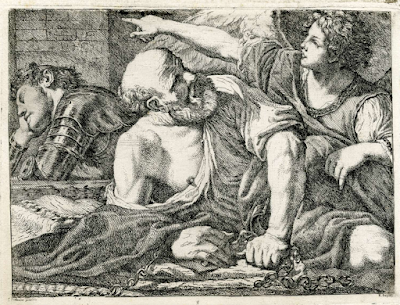 |
| Guercino (Giovanni Francesco Barbieri) St Matthew and the Angel ca. 1622 oil on canvas Pinacoteca Capitolina, Rome |
 |
| Ferdinand Joubert after Guercino St Matthew and the Angel 1835 etching British Museum |
 |
| Guercino (Giovanni Francesco Barbieri) Liberation of St Peter ca. 1622 oil on canvas Museo del Prado, Madrid |
"Economy of effort seems to explain why some of the motifs and compositional arrangement of the St Matthew and the Angel in the Pinacoteca Capitolina, Rome, painted at the same time as [the Liberation of St Peter in the Prado], seem to overlap."
 |
| Guercino (Giovanni Francesco Barbieri) Liberation of St Peter (detail) ca. 1622 oil on canvas Museo del Prado, Madrid |
 |
| Guercino (Giovanni Francesco Barbieri) Liberation of St Peter ca. 1622 drawing (study for both the Liberation of St Peter and St Matthew and the Angel) Art Gallery of South Australia, Adelaide |
 |
| Manuel Alegre after Guercino Liberation of St Peter 1793 etching and engraving Museo del Prado, Madrid |
 |
| Ramón Bayeu y Subias after Guercino Liberation of St Peter ca. 1785 etching British Museum |
 |
| Cayetano Palmaroli after Guercino Liberation of St Peter ca. 1832-37 lithograph Museo del Prado, Madrid |
 |
| Guercino (Giovanni Francesco Barbieri) Toilet of Venus ca. 1622-23 oil on canvas (trial version) Museum Kunstpalast, Düsseldorf |
 |
| Guercino (Giovanni Francesco Barbieri) Toilet of Venus ca. 1622-23 oil on canvas (finished version) Goethe Academy, Renaissance, California |
 |
| William Wynne Ryland after Guercino Toilet of Venus 1767 stipple-engraving Wellcome Collection, London |
"The Toilet of Venus was clearly influenced by Titian's Worship of Venus (Prado, Madrid) [directly below], which was originally in the Camerino of Alfonso d'Este at Ferrara but which by 1621 had passed into the Ludovisi collection, where Guercino could have seen it. He was clearly enraptured by its play of putti, which also inspired those in the frescoes he was painting in the Casino Ludovisi and those in his ceiling painting of St. Chrysogonus in Glory."
 |
| Titian Worship of Venus 1518-19 oil on canvas Museo del Prado, Madrid |
 |
| Guercino (Giovanni Francesco Barbieri) Memento Mori ca. 1622-23 oil on canvas private collection |
"On the right [of the Memento Mori] a putto polishes the top of a skull while holding a convex mirror up in one hand – a motif that is similar to the two convex mirrors raised by Archimedes in a drawing [directly below] in the British Museum, London, in order to defend Syracuse from attack by burning the ships of the Roman fleet. Here, the shiny top of the skull provides the other reflective surface to deflect the rays of the sun."
 |
| Guercino (Giovanni Francesco Barbieri) Archimedes deflecting the Rays of the Sun ca. 1622-23 drawing British Museum |
 |
| Guercino (Giovanni Francesco Barbieri) The Sudarium ca. 1623 oil on canvas private collection |
– quoted texts from The Paintings of Guercino: a revised and expanded catalogue raisonné by Nicholas Turner (Rome: Ugo Bozzi Editore, 2017)